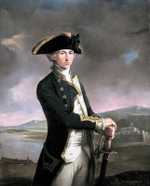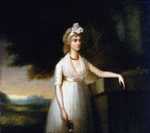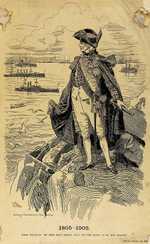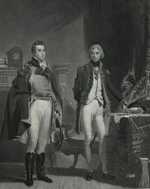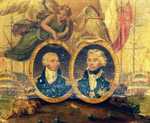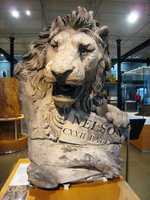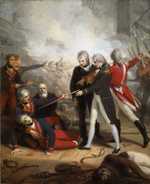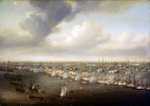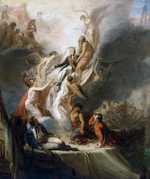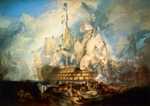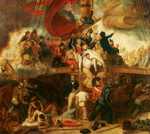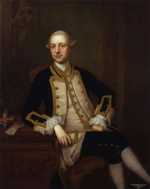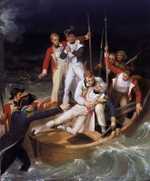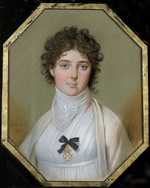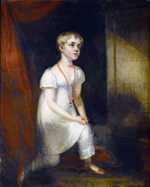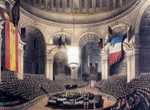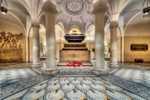1. Nelson's Early Years
Horatio Nelson was born on 29 September 1758 in Burnham Thorpe, Norfolk, England.
He was the sixth of 11 children of the village rector, Edmund Nelson, and his wife, Catherine.
Early life
Three of Catherine’s eleven children, borne over a period of seventeen years, died within weeks after birth.
Nelson’s family were poor, respectable and scholarly.
The Nelson family led a frugal life of self-denial. Some of Nelson’s siblings who had weak eyes were denied spectacles, which the family saw as a sign of self-indulgence.
Despite his fragile appearance, Nelson showed signs of fearlessness from a young age.
“I never saw Fear. What is it?”
he asked his grandmother at the age of nine.
The young Nelson attended school at Paston Grammar School in North Walsham and King Edward’s VI’s Grammar School in Norwich.
In short, Nelson's early life did not hint at the greatness that was to come.
2. Nelson joins the Navy
On 1 January 1771, at the age of 12, Nelson reported to HMS Raisonnable as an ordinary seaman and coxswain.
His duties were to include navigation and steering the ship.
HMS Raisonnable
HMS Raisonnable was a third-rate, 64-gun ship that had been captured from the French in 1768.
When the 12-year-old Nelson expressed interest in working on HMS Raisonnable in 1770, his maternal uncle, Captain Maurice Suckling—the commander of Raisonnable—remarked:
What has poor Horace done, who is so weak that he above all the rest should be sent to rough it at sea? But let him come; and the first time we go into action, a cannonball may knock off his head and provide for him at once.
At the time Nelson arrived, HMS Raisonnable was being prepared (commissioned) for an expected conflict with Spain.
Once the relationship between England and Spain had improved, Suckling was transferred to HMS Triumph and Nelson was sent to work on the merchant ship West Indiamen Mary Ann.
West Indiamen Mary Ann
Nelson sailed on Mary Ann from Medway, Kent, on 25 July 1771 to Jamaica and Tobago, returning to Plymouth almost a year later. He crossed the Atlantic twice while working on Mary Ann, from where he returned to work on Suckling’s longboat.
HMS Carcass
Shortly before his fifteenth birthday, Nelson found out that HMS Racehorse and HMS Carcass were setting sail on an exploration voyage to the North Pole. The purpose of the voyage was to find the North-East Passage through which India could be reached. Even though “persons under age” were considered as being of “no use” because of the extreme conditions the crew were to endure, Nelson was not deterred.
He begged the commander, Captain Skeffington Lutwidge, to join the crew as a coxswain. The captain relented and gave Nelson a place on Carcass. Within ten degrees of the North Pole, the ship got trapped in the ice and had to return. After his return, Nelson worked on HMS Triumph for a short while.
HMS Seahorse: Nelson’s first encounter with battle
Suckling then arranged for Nelson to be transferred to HMS Seahorse. In late-1773 Seahorse, under the command of Captain George Farmer, together with HMS Salisbury sailed for the East Indies, and they reached the British outpost at Madras on 25 May 1774.
In this time Nelson met Sir Thomas Troubridge, who was to become his friend for life. Nelson, who had been rated as a midshipman earlier on, was reclassified an able seaman in the year that they reached Madras in India.
During this time, the First Anglo-Marratha War between the British East India Company and Maratha Empire in India broke out. Seahorse was attacked by two ketches belonging to the ruler of the Kingdom of Mysore, Hyder Ali. They fired at their attackers and warded them off. This experience was Nelson’s first encounter with battle.
During this voyage Nelson fell ill with malaria. In Bombay his chances for survival seemed very slim, and he was transferred to HMS Dolphin and sailed for London. Due to the malaria Nelson became very depressed. He also became concerned that his naval career had come to an end, but the depression lifted after a while. By the time he arrived in London, he had almost recovered fully.
3. Moving up in the ranks
Suckling was promoted to Comptroller of the Navy in 1775. He helped Nelson to get a promotion, and he became acting lieutenant of HMS Worcester.
Promotion and more attacks of malaria
Nelson passed his lieutenant exams in 1777, and he got commissioned to HMS Lowestoffe that carried out cruises in the Caribbean. Nelson soon became the commander of Lowestoffe. He sailed on HMS Bristol and then HMS Badger. He was the master and commander of Badger, at which time he became a captain. In addition,he commanded HMS Hinchinbrook.
In this time, even though Nelson had fallen ill with malaria again, he stayed in the West Indies and then joined Major John Dalling in capturing Spanish colonies in Central America. Nelson was involved in the surrender of Castillo Viejo in Nicaragua. After Hinchinbrook he was transferred to HMS Janus, but after he fell ill again he was sent back to London on HMS Lion to recover.
HMS Albemarle
Once he recovered, Nelson took command of HMS Albemarle. He got to hand-pick Albemarle’s crew, saying “not a man or officer in her I would wish to change.” He felt different about the convoy though, which he said
“behaved as all convoys that I ever did see, shamefully ill”.
This was the time of the American Revolutionary Wars (with the Americans supported by the French), and Nelson was tasked with hunting American ships. When his ship entered West Indian waters, it captured a fishing vessel called Harmony. Her master, Nathaniel Carver, had to pilot HMS Albemarle though the waters of Boston Bay, an area Nelson and his crew were unfamiliar with. Nelson was so impressed with Carver and his crew’s efforts, that he returned their ship to them.
Two months after they had parted ways, Albemarle's crew ran out of food. Eight weeks later, they sighted Harmony. Carver was so grateful that Nelson had granted them their freedom that he gave them plenty of fresh supplies. Around that time Nelson and his crew were attacked by a powerful French force led by Louis-Phillipe de Vaudreuil, but they managed to escape. On 18 September 1782 Nelson arrived in Quebec, where his crew was hospitalized and treated for scurvy.
After this Albemarle set sail for New York, where she was transferred to Admiral Samuel Hood’s fleet at Nelson’s request, and they set sail for the West Indies. They scouted the area for signs of De Vaudreul’s force, but it soon became clear that their enemy had eluded them. Nelson launched an attack on the French garrison of the Turks Islands, but they had to retreat.
Nelson arrived back in Britain in the middle of 1783.
HMS Boreas
In 1784 Nelson considered standing for Parliament, but he was unable to find a seat.
In the same year Nelson received command of HMS Boreas and was tasked with enforcing the Navigation Acts around Antigua. Nelson and his superior, Admiral Sir Richard Hughes, often disagreed about their individual interpretation of the Acts.
During this time, Nelson was held on HMS Boreas for eight months after being sued by American captains for illegally taking hold of their vessels. The courts ruled in his favour, and he was free to go. Nelson stayed with Boreas until she was retired later in 1787.
Nelson marries Frances Nisbeth
In this time Nelson met Frances Nisbeth, a young widow from the island of Nevis in the Caribbean. He fell in love with her and her uncle, John Herbert, offered him a massive dowry.
The dowry was never paid, but Nelson went ahead and married her on Nevis on 11 March 1787.
Married life and HMS Agamemnon
The Nelsons lived between Bath and London, until they moved to Nelson's childhood home at Burnham Thorpe. Nelson tried to find a ship to command, but as there were no wars at the time there were not enough ships. This left him in reserve and on half pay.
The French revolutionary wars broke out soon though, which set France against Britain, Austria, Prussia and Russia amongst others. The Admiralty gave Nelson command of HMS Agamemnon in January 1793 following the French occupation of the Austrian Netherlands, which is known as Belgium today.
From Gibraltar to Sardinia: Nelson meets Emma Hamilton
Under the command of Vice Admiral William Hotham, Nelson set sail for Gibraltar in May 1793. Soon thereafter they were joined by the rest of Hood's fleet. From there they sailed to Toulon in France where—under the threat of their internal enemies—the authorities had asked Hood for protection.
Hood sent Nelson to Sardinia and Naples in Italy with messages asking for reinforcements. In Naples Nelson met King Ferdinand IV; as well as the British ambassador, William Hamilton, and his wife, Emma. The mission was a success, and 2,000 men and a number of ships were mobilised as a result.
On 5 October, when Nelson arrived back in Toulon, he found that a large French army had surrounded the city and was bombarding it. Hood was confident that Toulon would be safe once the reinforcements arrived, and sent Nelson to join a squadron off Cagliari in Sardinia.
Tunis
On 22 October 1793 Agamemnon saw five sails, which turned out to be a French squadron. Nelson gave chase, and fired on the Melpomene. He had to withdraw when it transpired that he was outnumbered, and he kept on to Cagliari where he stopped over briefly to do some repairs.
From there he set sail for Tunis with a squadron under Commodore Robert Linzee. In Tunis Nelson was assigned to blockade the French garrison on Corsica, at which time he was given command of a small squadron—Agamemnon and four smaller vessels.
Corsica
Hood assigned extra ships to Nelson in January 1794 because Britain needed Corsica as a naval base after the fall of Toulon. Lieutenant David Dundas and Nelson couldn't agree on whether or not it was a good idea to attack the Corsican town of Bastia, but they were given the go-ahead in late March.
Nelson led the land forces and started bombarding Bastia, and the British squadron opened fire from the harbour side. As a result, Bastia surrendered after 45 days.
Calvi: Nelson loses his right eye
Nelson then joined forces with General Charles Stuart to launch an attack on the Corsican commune of Calvi. One morning Nelson was struck by debris from a sandbag that was hit during battle. His eye was bandaged, and he returned to action.
The British intensified their onslaught on Calvi, and they were forced to surrender on 10 August 1794. Nelson’s right eye was seriously injured, and he lost sight in it.
Hotham replaces Hood
Nelson was then tasked with building diplomatic relations with Genoa in Italy. After this, Hood was replaced in the Mediterranean by Hotham, who then joined Nelson. After receiving news that the French were heading for Corsica, Hotham tried to cut them off, but they tried to avoid confrontation.
The two fleets ended up shadowing each other. The British forced two French ships, Ca Ira and Censeur to surrender. At the time Censeur was towing Ca Ira, which had collided with another ship during the chase. As a result, the French decided to not invade Corsica and returned to port.
Genoa
On 4 July 1795 Agamemnon together with a few frigates and sloops set sail from St Fiorenzo in Corsica to Genoa, after they had spent a while in the Mediterranean. Two days later Nelson returned to St Fiorenzo when a number of significantly larger French warships pursued him.
Nelson alerted the British fleet, and Hotham chased them to the French Hyères Islands. In Genoa Nelson failed to sell Hotham on his plans to thwart the progress of the French Army of Italy. At the time, the French were raiding around Genoa.
Hotham was replaced by Sir Hyde Parker in November. At the end of November, Nelson managed to cover the army that was withdrawing due to a sizeable French attack. He did not have enough men and ships to optimize his strategy though, and the British ended up withdrawing from the Italian ports. Nelson returned to Corsica.
Leghorn
Sir John Jervis became commander-in-chief of the fleet in the Mediterranean. Nelson was appointed to HMS Captain, and Agamemnon was sent back to Britain for repairs. When the French tried to capture Leghorn in Italy, Nelson went there and oversaw the evacuation of British nationals and took them to Corsica.
He then returned to Leghorn to blockade the port. He left for Gibraltar, and joined Jervis on the way.
4. Battle of St Vincent
Nelson and Jervis met with a Spanish fleet of 27 ships in mid-February 1797.
Jervis planned to cut between the two divisions of the fleet, and to destroy the one half before the other one could assist. It soon transpired that the British ships would not be able to turn soon enough before the Spanish squadrons closed up.
Battle of Cape St Vincent
Nelson (commanding HMS Captain) broke out of line in contravention of his orders, and directly engaged with San Josef, San Nicolas and Santisima Trinidad. HMS Culloden came to Captain's assistance.
Although Captain and Culloden were severely damaged, Nelson captured San Nicolas and San Josef (with another two Spanish ships surrendering to the British).
Because of the victory, and because Jervis was fond of Nelson, he was not reprimanded for disobeying direct orders. Following this, Jervis was made Earl of St Vincent and Nelson was made a Knight of the Bath.
Around the time he also received a standard promotion that was due to him, and he became Rear Admiral of the Blue.
After Cape St Vincent
In May 1797 Nelson was given HMS Theseus as his flagship and tasked with monitoring the Spanish fleet around Cadiz in Spain. He had to lie ahead of Spanish treasure ships returning from the American colonies. When Nelson attacked Cadiz on 3 July he was nearly cut down, but a seaman called John Sykes took the blows and was badly wounded. The British seized a Spanish boat and towed her back to Theseus.
Battle of Santa Cruz de Tenerife: Nelson loses his arm
Around this time Nelson started devising a plan, consisting of naval bombardments and an amphibious landing—to capture Santa Cruz de Tenerife and Principe de Asturias, a treasure ship that had just arrived. All three attempts failed. Their first attempt was thwarted by unfavourable currents and the second attempt was beaten back.
Nelson personally led a battalion during the following attack, which they launched at night. During this attack he was hit by a bullet that broke his upper right arm in several places.
He was rowed back to Theseus, where the surgeon Thomas Eshelby amputated most of his arm. Half an hour later he returned to duty.
Sir Thomas Troubridge had to negotiate with the Spanish because the British boats had been sunk and they were cut off from their fleet. The Spanish gave them permission to retreat. A quarter of the landing force was wounded or killed during the attack. The squadron joined Jarviz off Cadiz, and Nelson set sail for England on Seahorse.
Recovery in England
Nelson was welcomed enthusiastically when he arrived at Spithead on 1 September. He was seen as a hero because of the victory at Cape St Vincent. His countrymen did not hold him accountable for the defeat at Santa Cruz de Tenerife.
He moved to Bath with Frances. From Bath he then moved to London to get better treatment for his arm, where he was awarded the Freedom of the City of London. He bought Round Wood Farm near Ipswich with his pension of £1,000 a year. Nelson swiftly recovered from his amputation, and he started looking for a ship to command.
After his recovery
When Napoleon was gathering forces in Southern France, Nelson was given command of HMS Vanguard, and he was sent to Cadiz to strengthen the fleet. Nelson set sail on 28 March 1798 to join Jarvis, who then sent him to Toulon with a small force to survey French activities.
In search of Napoleon’s men
When Nelson passed through the Straits of Gibraltar and took up position off Toulon, his squadron was dispersed and blown southward by a strong wind. Reinforced by ships from Jarvis, he started searching the Italian coast for Napoleon’s fleet. In the meantime Napoleon had arrived in Malta near Italy and captured it.
When Nelson arrived in Malta, Napoleon had left. Nelson and his captains concluded that Napoleon was probably headed for Egypt, and they set sail for Alexandria in Egypt. They started searching east of the port when they did not find the French in Alexandria.
Napoleon’s fleet arrived in their absence, and landed their forces unopposed on 1 July. The French Vice-Admiral François-Paul Brueys d'Aigalliers anchored his fleet in Aboukir Bay. After a few more failed attempts to locate the French, they found their fleet in the bay on 1 August 1798 -- setting the scene for the Battle of the Nile.
5. Battle of the Nile
The British arrived late in the day on 1 August 1798 and caught the French by surprise.
The Battle
Nelson immediately commanded his ships to advance, and they attacked the French on both sides.
Soon the British fleet was systematically engaging with the French ships. Nelson was wounded in the forehead by a piece of French shot while he engaged the French ship Spartiate and came under fire from Aquilon, but the wound turned out to be fairly minor (at least by Nelson's standards!).
Soon the front division of the French fleet started surrendering. And French Admiral Brueys’s flagship, Orient, caught fire and exploded after it was continuously fired on.
This attack was a major setback for the French. The French fleet had almost completely been wiped out, and Napoleon’s forces were stranded in Egypt.
Although he is best known for the Battle of Trafalgar, the The Battle of the Nile is seen by many historians as the most important achievement of Nelson’s career.
After the Nile
Nelson sailed to Naples, where he received a warm welcome. The King of Naples and the Hamiltons—whom he had met a few years earlier when Hood had sent him to get reinforcements for Toulon—personally welcomed Nelson at the port, and William Hamilton invited him to stay at their home.
Over time some officers noticed that Nelson seemed attracted to Emma Hamilton, which troubled Jervis. In the meantime, the news of Nelson's victory in Egypt had reached London, and it was celebrated enthusiastically across the country.
Nelson received awards from the City of London, the Tsar of Russia and the Sultan of the Ottoman Empire.
Indeed, The First Lord of the Admiralty, Earl Spencer, awarded Nelson the title Baron Nelson of the Nile. But Nelson believed that he should have been awarded a Viscountcy, and he felt insulted!
Spencer's position was that because Nelson had commanded a squadron and not a fleet, it would set an undesirable precedent if he were to make Nelson a viscount.
It was at about this time that Nelson started appearing more frequently in public with Emma.
Nelson assists his Neopolitan friends
When King Ferdinand of Naples declared war on France, the Neapolitan army retook Rome from the French with the support of Nelson’s fleet. The French then got reinforcements and defeated the Neapolitans, who fled back to Naples.
Nelson arranged the withdrawal of the British nationals, the Royal family, numerous nobles and the Hamiltons from Naples. The evacuees were sailed to nearby Palermo, which they reached on 26 December 1798. On 14 February 1799 Nelson was promoted to Rear Admiral of the Red.
He besieged Naples, which was occupied by the French at the time. In late-June the Sanfedisti, a counter-revolutionary force under Cardinal Fabrizio Ruffo, forced the French to take shelter in the city's fortifications. Ruffo made an agreement with the French, which enabled them to return safely to France. When Nelson arrived in Naples he was furious, and he—supported by Ferdinand—demanded that the French had to surrender unconditionally.
He arrested the French that had surrendered under the treaty, as well as Admiral Francesco Caracciolo, a Neopolitan who had switched sides. Caracciolo was hanged, and hundreds of the French were handed over for trial and execution. To thank Nelson, King Ferdinand awarded Nelson the title Duke of Bronté and some properties.
Nelson returned to Palermo. He was made the senior officer in the Mediterranean after George Elphinstone, Jervis’s successor, went after the French and Spanish fleets into the Atlantic. When Elphinstone returned in February the next year, Nelson was put to sea again. Nelson impressed Elphinstone by capturing the french ship Généreux, which had not been destroyed in the Battle of the Nile.
Back to England
In April 1800 Nelson joined the Hamiltons on a cruise around Malta on the HMS Foudroyant. William Hamilton condoned his wife’s affair with Nelson. Nelson then transported the Queen of Naples to Leghorn. Here he shifted his flag to HMS Alexander, defying Elphinstone who had commanded him to join the main fleet.
This was not the first time that he was insubordinate to Elphinstone, and he was sent back to London. Earl Spencer had already suggested that Nelson should return to London when rumors of Nelson's affair with Emma reached him.
Nelson was pleased to return to England, because William Hamilton had been recalled to London as well. Nelson, the Hamiltons and other British travellers left Leghorn on 13 July. They made numerous stops during their journey. Nelson received a hero's welcome along the way, and they were entertained by local nobility.
They arrived in London on 9 November, where Nelson was promoted to the second-in-command of the Channel fleet under Jervis. At this time, Frances Nelson and Emma Hamilton met for the first time. It became obvious that Nelson was no longer interested in his wife, and that he was attracted to Emma.
Around Christmas, Frances issued him an ultimatum. He refused to choose Frances over Emma, and the Nelsons separated. On 1 January 1801 Nelson was promoted to Vice Admiral of the Blue, and he was granted the freedom of the city in Plymouth on 22 January 1801.
Emma gave birth to their daughter Horatia on 29 January 1801.
6. Battle of Copenhagen
Shortly after Horatia’s birth, Nelson was ordered to move his flag from HMS San Josef to St George for an expedition to the Baltic.
Battle of Copenhagen
At the time the Danish, Swedish, Russian and Prussian governments had formed an alliance to break the British blockade that was stopping and searching their merchantmen. Nelson joined Sir Hyde Parker’s fleet and they sailed for Denmark in March.
Parker’s plan was to blockade Denmark, but Nelson wanted to attack the Danish fleet at Copenhagen in Denmark. They agreed to an assault, and Parker would wait in the nearby Kattegat sea. On the morning of 2 April as Nelson sailed into Copenhagen harbour, Agamemnon ran ashore before she entered the channel, and soon thereafter HMS Russel and HMS Bellona suffered the same fate.
Three ships down and under heavy fire from the Danish forces, Parker signalled to Nelson to retreat.
Nelson, facing the direction of the signal from HMS Elephant, placed his telescope against his blind eye and told his flag captain:
“I really do not see the signal!”
Only one of Nelson’s captains. Edward Riou, withdrew. This exposed him to heavy fire and he got killed.
The battle then swung in favour of the British, and a few hours later when Nelson sent a message to the Danish-Norwegian regent Crown Prince Frederik, he accepted Nelson’s offer of a truce. Negotiations started the following day, which resulted in a fourteen-week armistice.
After this, Nelson returned to London to visit the Hamiltons.
Nelson was rewarded for the victory at Copenhagen and created Viscount Nelson of the Nile and of Burnham Thorpe in the County of Norfolk. Following this he was created Baron Nelson, of the Nile and of Hilborough in the County of Norfolk, which included a special remainder to his father and sisters.
After the Battle of Copenhagen
Napoleon started gathering forces to invade Britain, and Nelson was tasked with defending the English Channel. He had to return to London for a while due to health problems, and he stayed with the Hamiltons. William Hamilton died in April 1803.
Nelson was made commander-in-chief of the Mediterranean Fleet and received HMS Victory as his flagship. He sailed to Malta from where he joined the blockade of Toulon, and he got promoted to Vice Admiral of the White on 23 April 1804. Nelson returned to Gibraltar at the end of July, and sailed from there to England.
He was concerned about his failure to bring the French to battle, but once again he received a hero’s welcome back home. He visited Emma, and planned an attack on the enemy fleet. News had reached England that the French and Spanish fleets had joined forces at Cadiz. Nelson was given command of the fleet that was blockading Cadiz.
In Cadiz Nelson’s plan for an attack took further shape, and he decided to split his fleet into squadrons rather than forming it into a similar line parallel to the enemy.
7. Battle of Trafalgar
Admiral Pierre-Charles Villeneuve, who was in charge of the combined fleet at Cadiz, was apprehensive to risk an engagement with the British, and he was replaced by Admiral François Rosily.
The Battle of Trafalgar
Rosily was supposed to sail the fleet from Cadiz to the Mediterranean to land troops at Naples, before going to Toulon. Villeneuve decided to sail the fleet out before Rosily arrived, and on 20 October 1805 the fleet was sighted by British frigates. Nelson was informed of their movements.
Early the following morning Nelson ordered the Victory to turn towards the French fleet. He then finalized his will and wrote a final prayer. Victory's captain, Thomas Hardy, suggested that Nelson remove the decorations on his coat so that he would not be spotted by the enemy easily, but he refused.
Victory led the line into battle, and it came under fire. Nelson's secretary, John Scott, was killed after being hit was hit by a cannonball, and soon thereafter the captain’s clerk.
Victory lost its wheel, and another cannonball killed eight of Nelson’s crew. Redoutable and Santisima Trinidad were both firing at Victory, but Nelson and Hardy kept on giving orders and walking about on the deck.
The result
The Battle--between 27 British ships and 33 French vessels--was later to be won by the British. Remarkably, the French lost 22 ships with the British losing none. This was largely due to Nelson's audacious tactics of arranging his ships into two lines and sailing straight at (perpendicularly to) the enemy.
8. Nelson’s Death
In the early afternoon Hardy realised that Nelson was missing.
Nelson had been shot in the back by a marksman, and had collapsed. Smiling, he said:
“Hardy, I do believe they have done it at last ... my backbone is shot through.”
Nelson’s Death
He was taken to the surgeon, William Beatty. He asked Beatty to remember him to Emma, his daughter and his friends, and he asked that Emma would receive his possessions.
The chaplain, Alexander Scott, said Nelson’s last words were "God and my country", and he died three hours after he had been shot. Victory was towed to Gibraltar after the battle with Nelson’s body onboard, and dispatches about the battle were carried to England on HMS Pickle. When Emma received the news, she screamed, collapsed and was unable to speak for many hours.
King George III reportedly said
"We have lost more than we have gained."
The British forces had defeated the combined French and Spanish fleet.
Funeral
Nelson's body was preserved in a cask of brandy or rum and returned to England.
Nelson was laid to rest at St Paul’s Cathedral in London on 9 January 1806. An escort of 10,000 soldiers carried his coffin from the Admiralty to the Cathedral, and his funeral procession was made up of 32 admirals and more than a hundred captains.




